There is no doubt that Vietnamese fruits are one of the best fruits in the world. The tropical climate is suitable for many astonishing types of fruit trees growing nationwide. People say Vietnam is the heaven of foods, but it would be a pity to miss Vietnamese fruits.
The fruits in Vietnam are extremely diverse, exotic, and health-conscious. If you are wondering what the best Vietnamese fruits are, this post is for you. Let’s discover the ultimate list of Vietnamese fruits here.
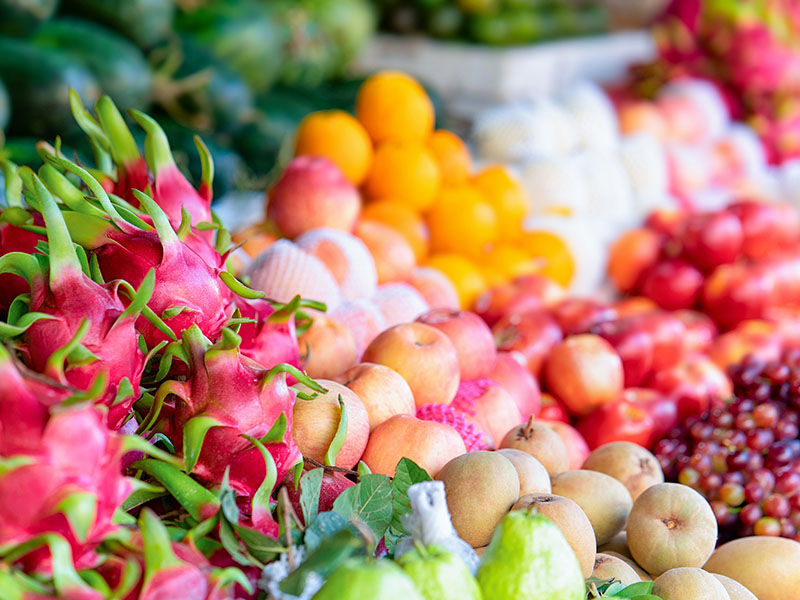
6 Most Delicious And Popular Drupe Fruits In Vietnam
As you may know, a drupe is a type of fleshy fruit which contains a hard single seed in the center. So, let’s check out which Vietnamese fruits belong to this category. They are the favorite fruits of many people, and one of them is even the symbol fruit of Hanoi.
1. Rambutan (Chôm Chôm)
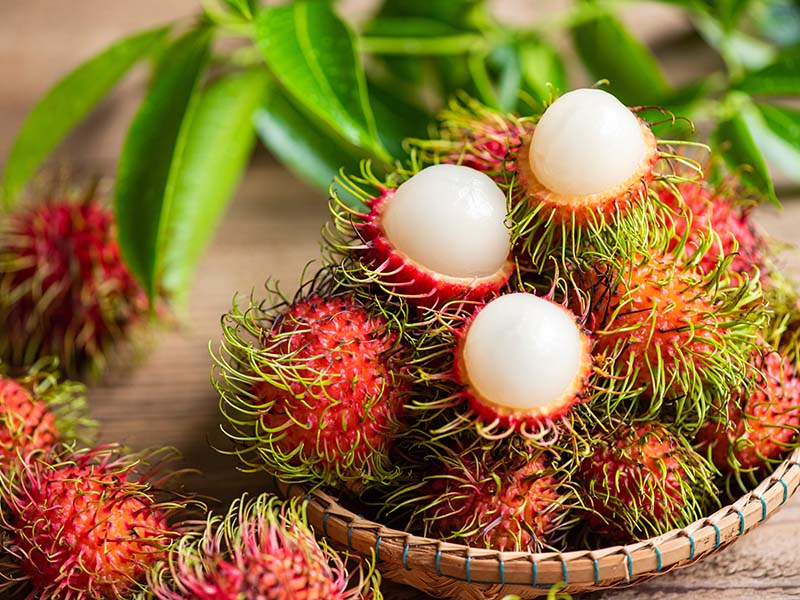
I can’t help thinking about Rambutan when mentioning drupe fruits in Vietnam. This is one of my favorite Vietnamese fruits because of its sweet and chewy flesh. There are many types of Vietnamese Rambutan, and I will help you pick out the best one.
In general, Rambutan has a bizarre look with a hairy grind. The most delicious type is Chom Chom Nhan, which is smaller in size and has shorter hair than other types. The typical color is yellow, greenish-yellow, and red when ripe. Its flesh is sweet like candy and chewy.
You can get the pit out of the flesh in Chom Chom Nhan much easier compared to other types. Rambutan is affordable and a good source of fiber and vitamin C, so many Vietnamese people love this fruit.
Nutrients: Rich in dietary fiber, vitamin C, copper, manganese, potassium, phosphorus, magnesium, iron, and zinc.
Season: Normally from May to July.
How to eat: Rambutans taste the best when eaten fresh. Use a knife to gently cut the hairy rind in half until you see the flesh inside. You can also use your thumbnail to tear the rind. Eat the flesh and throw away the seed.
This street food vendor sells three different types of Rambutan, and the smallest one is the best.
2. Longan (Nhãn)
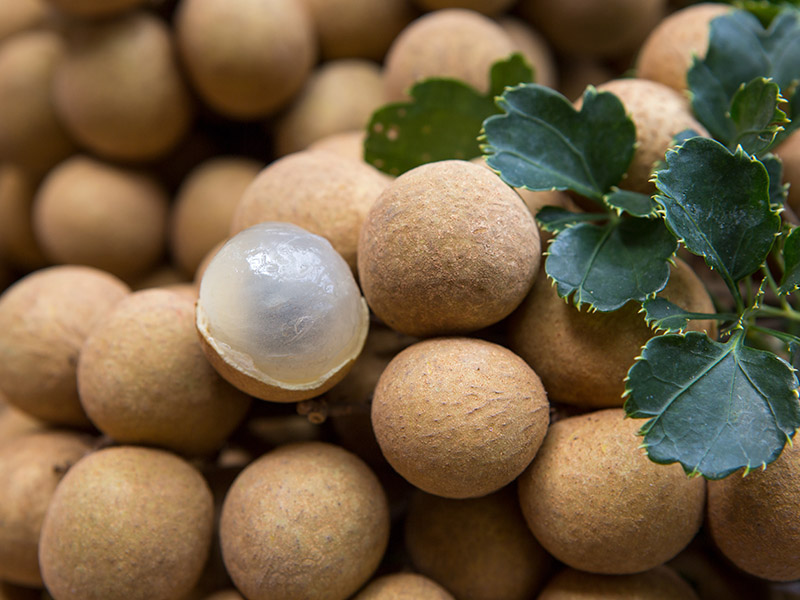
The next one on the list is Longan, a tropical fruit growing mostly in Asian countries. Longan originated from tropical Asia and China.
Its name means ‘dragon eyes’ in Cantonese. The reason behind its name is the black seed covered in translucent white flesh resembling dragon eyes.
In Vietnam, Longan is a popular fruit. People consider it a real treat for summer. Longan is a round fruit with leathery yellow or brown skin. Its thin translucent flesh has a sweet and addictive flavor, which makes you keep eating.
The most famous and delicious type of Longan in Vietnam is ‘Nhan Long Hung Yen’ from Hung Yen province. Its flesh is much thicker and sweeter compared to other types. People think that it used to be one of the precious specialties offered to the King back then.
Nutrients: Carbohydrate, dietary fiber, vitamin B1, vitamin C, but high sugar level.
Season: Harvested in summer, from July to August
How to eat: Eat raw by tearing the skin and removing the seed. The combination of longan and lotus seed is a perfect dessert.
3. Lychee (Vải)
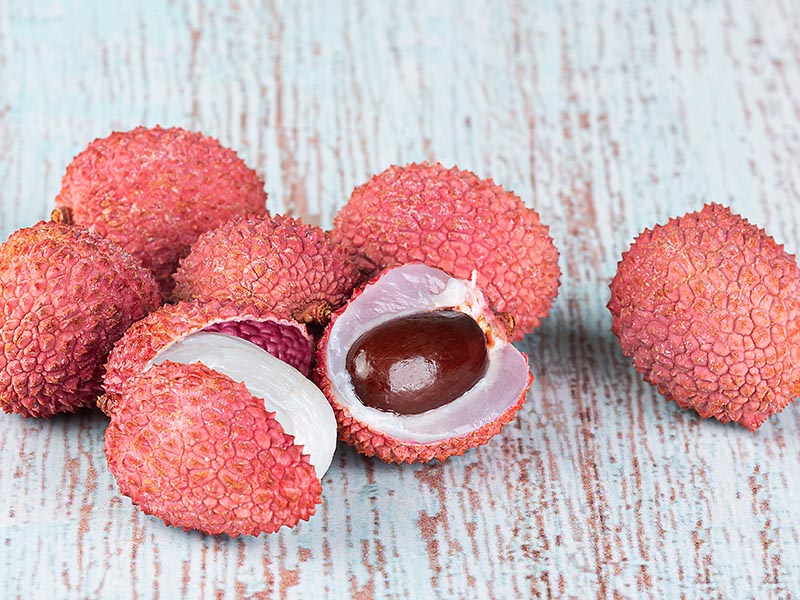
Just like Longan, Lychee is a native fruit in China. These tropical fruit trees grow mostly in China, India, and Southeast Asia. In Vietnam, Hai Duong and Bac Giang provinces are well-known for the delicious types of Lychee.
Lychee is a round-to-ovoid-shaped fruit with red or pinkish-red rough skin. It has typical features of a drupe fruit with pulp covering a hard seed. Its pulp is juicy, tender, and sweet. No wonder why it is one of the most expected fruits when summer comes in Vietnam.
Just like Chinese and Vietnamese cuisine, Chinese Lychee and Vietnamese Lychee are different. While Chinese Lychee has a better appearance with its big size and red color, Vietnamese Lychee outweighs it with its tasty flavor.
Though it is an amazing fruit, consuming too much Lychee can cause sore or itchy throat and acne. Lychee contains a high level of sugar, so people with diabetes should think twice before eating Lychee. You also must remove the seeds since they contain a small amount of poison.
Nutrients: Carbohydrate, vitamin C, potassium, copper, and antioxidants.
Season: Peak season from June to July.
How to eat: Best to eat fresh without rind and seeds. Two more ways to enjoy it are making iced Lychee tea and lotus seed with Lychee dessert.
This Lychee eating review will make your mouth water.
4. Mango (Xoài)
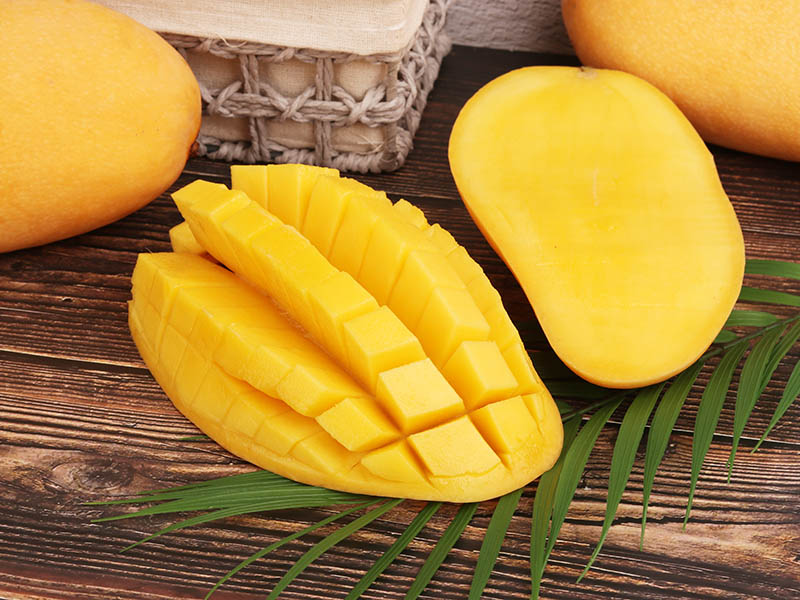
Mango is a tropical fruit whose origin is in Southeast and South Asia. It is grown mostly in the West Malesia region, Myanmar, and India. In Vietnam, it is a popular fruit that many people love and consume in daily life and at parties.
Mango is available all around Vietnam and mostly in the Mekong Delta. Its peak season is in summer, but it is also available in other seasons, albeit at higher prices. There are several types of Mango in Vietnam, and the most typical ones are Xoai Cat and Xoai Tuong.
Xoai Cat has light yellow skin. Its flesh is smooth, sweet, and fragrant. On the other hand, Xoai Tuong has a bigger size, green-hued skin, crunchy texture, and slightly sour flavor. Unripe Xoai Tuong tastes best when served with a sweet-spicy sauce.
Nutrients: Dietary fiber, antioxidants, vitamin A, vitamin E, and vitamin C.
Season: Almost all year round, but the peak season is from April to July.
How to eat: For ripe yellow Mango, peel and slice to eat. Most people love to pierce the flesh in a cross-hatching pattern. For green, unripe Mango, slice and dip in chili-salt mixture or spicy, sugary fish sauce.
5. Ambarella (Cóc)

Ambarella is another popular drupe fruit on this list. Despite belonging to this fruit category, Ambarella is much different from others with the fibrous and hairy pit. Therefore, it is much harder to remove the seed out of the flesh.
Ambarella has an oval shape, green or greenish-yellow, and spotted skin. The pulp is white or slightly yellow and crunchy. It is much more sour compared to other drupe fruits in Vietnam. The closer the flesh to the pit, the sweeter it is.
Ambarella is a familiar street food in Vietnam. Most street fruit vendors sell skilfully-sliced Ambarella with a mouthwatering chili-salt mixture. It is the favorite of the young in Vietnam. Furthermore, most Vietnamese people believe Ambarella accelerates recovery from cold.
Nutrients: Dietary fiber, carbohydrate, potassium, phosphorus, and vitamin C.
Season: Begin in May until October or November.
How to eat: Peel the skin and eat the flesh inside. The Vietnamese love eating Ambarella with a spicy, salty sauce.
6. Plum (Mận)
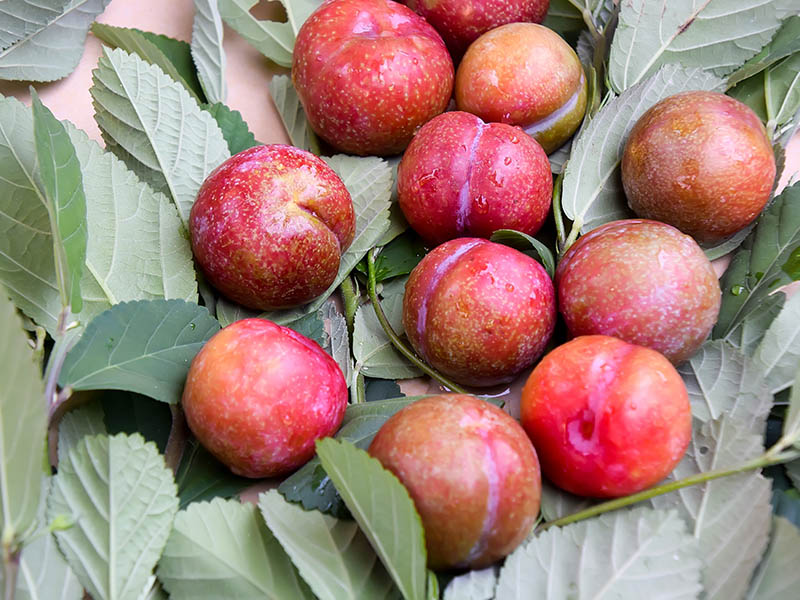
Plum is a popular fruit in Northern Vietnam and China. This fruit makes Northern Vietnam a famous destination. From late January to mid-February, people flock to the North, especially Moc Chau province, to contemplate white Plum blossoms covering vast areas.
Then around May to June, the flowers turn into millions of round red fruits, which attract many people to visit and enjoy the juicy plum. With an affordable entrance fee, you are free to pick and enjoy the fresh Plum right in the farmers’ garden.
Plum is one of the most addictive fruits with its sour, sweet, and juicy flesh. The locals love to peel the skin, slice it into pieces, and shake them well in the mixture of sugar, salt, and chili. That would be the best way to welcome summer.
Nutrients: Dietary fiber, carbohydrate, vitamin A, vitamin C, and vitamin K.
Season: The harvesting season is around May to June.
How to eat: Best to eat raw with a mixture of sugar, salt, and chili. Some love to make dried Plum wine.
Taking part in this Plum harvest festival in Moc Chau is an unforgettable experience.
7. Coconut (Dừa)
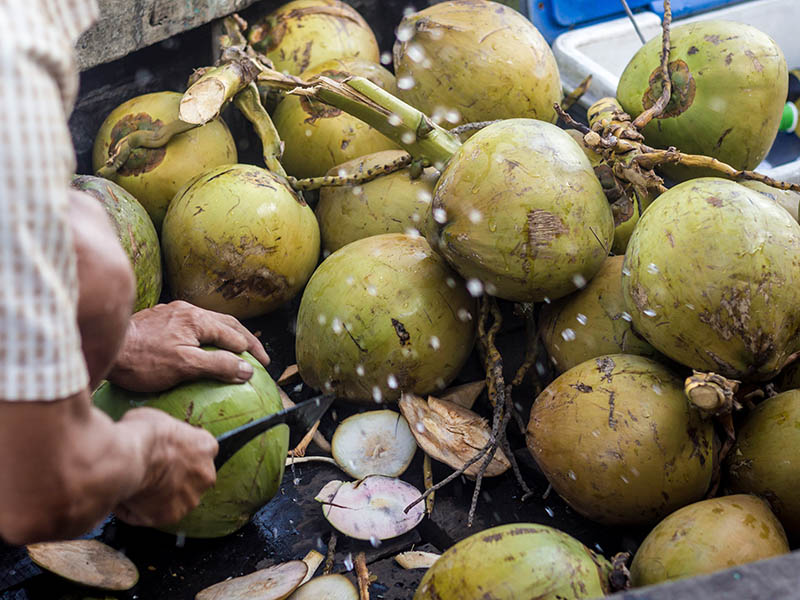
You may feel weird when Coconut is classified into the drupe fruit family as it seems not to contain any seeds inside. But the Coconut itself is a giant seed. At the end of a coconut, there are three pores, from one of which a shoot emerges when the seed germinates.
Coconut is a typical tree in tropical areas. According to the International Coconut Community (ICC), Vietnamese Coconut is one of the best in terms of quality and productivity. Coconut is a favorite of many Vietnamese people because of the delicious pulp and juice.
Coconut juice is one of the best beverages in Vietnam with naturally-sweet flavor and nutrients. The older the Coconut gets, the crunchier the pulp is. Besides eating fresh, Coconut candies in Ben Tre province are also well-known in Vietnam.
Nutrients: Carbohydrate, vitamin C, vitamin B, potassium, sodium, and iron.
Season: All year round, especially in August and September.
How to eat: Chop out to enjoy the pulp and the juice inside. Or you can pierce a hole at the bottom of a Coconut and turn it upside down to drink its water.
8. Dracontomelon (Sấu)
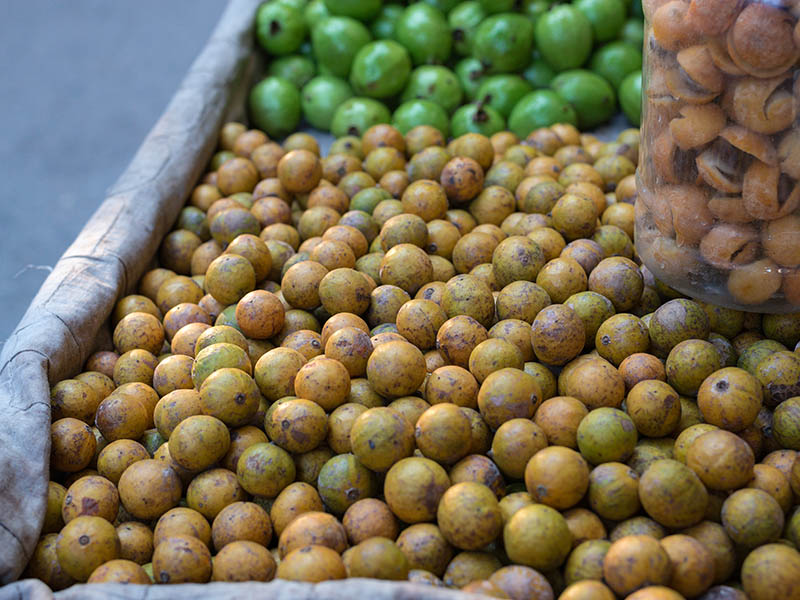
Dracontomelon is a popular tree in Northern Vietnam and the symbol fruit of Hanoi – the capital of Vietnam. In the peak season, Dracontomelon trees along the streets in Hanoi produce fruits, which creates a uniqueness to this city.
Dracontomelon is a round, green fruit with a single seed. It is one of the most versatile Vietnamese fruits, so the locals come up with so many ways to enjoy it. The most popular way is peeling the outer, then soaking in the mixture of water and sugar or ginger.
Another favorable way is to pickle it with spicy and sweet fish sauce. The locals also combine Dracontomelon with many tasty dishes such as simmered duck, minced pork soup, and simmered pork legs.
Nutrients: Gluxit, calcium, phosphorus, and vitamin C.
Season: From June to September.
How to eat: Peel the outer and pickle with sugar, salt, ginger, or chili.
5 Awesome Vietnamese Fruits Belong To Berry Fruit Category
Fruits that belong to the berry category come with fleshy pulp without a hard stone in the middle. They are produced from a single flower. Based on these botanic features, here are the 5 most favored berry fruits in Vietnam.
9. Banana (Chuối)
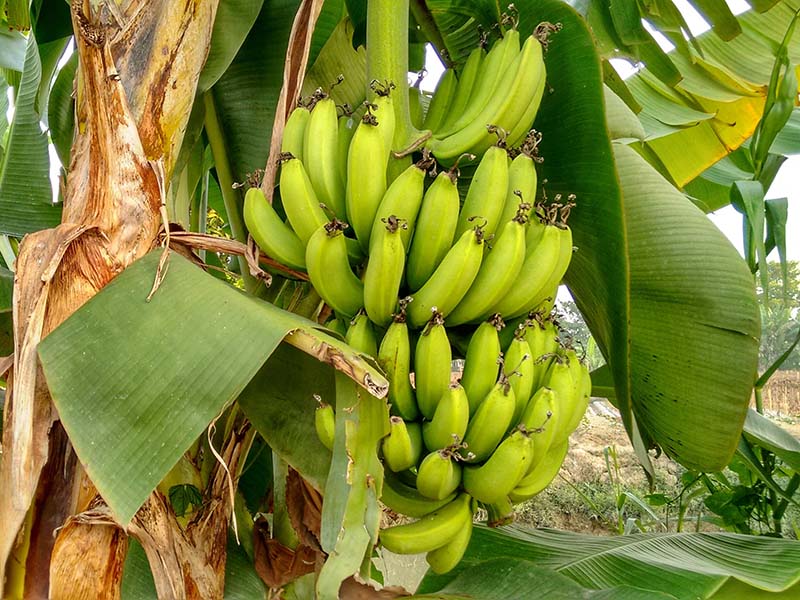
Banana is a native fruit of Southeast Asia and Australia. It is now developing almost everywhere in tropical areas. Banana is a familiar food to the Vietnamese, especially those living in rural areas. Some kids grow up with Banana gardens.
There are several types of bananas in Vietnam, but the most popular ones are Chuoi Gia Huong, Chuoi Cau, Chuoi Tieu, and Chuoi Su. In most types, ripe bananas have a long and curved shape with yellow skin or greenish-yellow. The flesh of a Banana is soft and sweet.
The Vietnamese make use of the Banana for many purposes. They use the unripe to cook soup with shrimp and piper lolot, the Banana flower to make salads, and the leaves to wrap traditional cakes.
Nutrients: Carbohydrate, pectin, potassium, vitamin B6, vitamin C, and antioxidants (dopamine and catechin).
Season: All year-round.
How to eat: Gently peel the skin and enjoy the flesh inside.
10. Guava (Ổi)

Guava is a common tropical fruit that originated in Brazil and is grown in many tropical and subtropical areas. There are two main types of Guava in Vietnam: white guavas and red guavas. Both are round or oval with edible thin yellow or green rind.
The pulp inside is off-white for white guava and deep pink for the red types. They both taste sweet or sour. Vietnamese people, especially the young, love incorporating guava in many dishes at gatherings or parties. They often serve raw guava with salt and chili mixture.
Most Guavas have many hard little seeds, but some types are now seedless. It is an excellent source of vitamin C. Guava contains 4 times more vitamin C than an orange. Therefore, it is not only a mouthwatering fruit but also super beneficial for your health.
Nutrients: Vitamin C, vitamin A, dietary fiber, potassium, sodium, iron, acid folic, and vitamin B9.
Season: Can produce fruits all year round. But in the North, Guava trees mainly produce fruits from June to August, though there are variants that give fruits all year round. Guavas in Southern Vietnam are available all year round, but the peak season is from May to October.
How to eat: Wash thoroughly and cut into slices to enjoy. Highly recommend removing seeds.
Here is a recommended way to eat guava Vietnamese style.
11. Watermelon (Dưa Hấu)

Watermelon is a vine-like plant derived from Africa and cultivated mostly in tropical and subtropical regions. In Vietnam, people grow Watermelon from the North to the South. The fruit is large, round, or oval-shaped with striped green skin and sweet red flesh.
Watermelon normally contains many black seeds, though the seedless type is now available. As you may know, Watermelon is one of the juiciest fruits ever. Nothing better than satisfying your thirst with watermelon.
In addition to being consumed in daily life, Watermelon is one of the favored fruits during the Tet holiday. The local people skillfully carve lucky words and pictures on the skin to pray for happiness and prosperity.
Nutrients: Carbohydrate, vitamin C, vitamin A, vitamin B5, potassium, and copper.
Season: People can harvest Watermelon after 2 months of growing. In the North, the main crop is at the end of May, late July, and early December. In Southern Vietnam, the peak season is at the end of December, during Lunar New Year (early February), and after the Tet holiday.
How to eat: Peel the cover, and cut it into slices to eat. Or cut it in half and use a spoon to eat.
12. Grape (Nho)
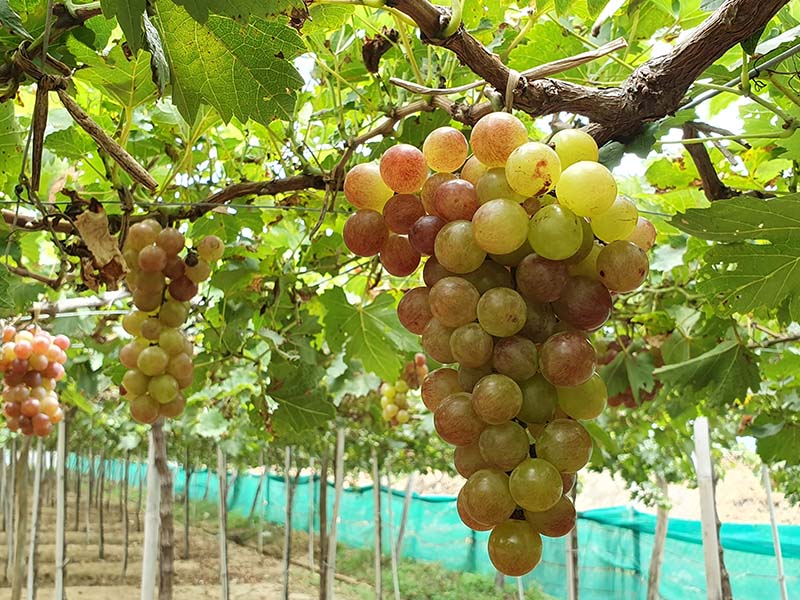
Grape is a popular fruit in many countries, including Vietnam. Ninh Thuan province in Southern Vietnam produces the best quality and quantity of grapes in Vietnam. When visiting Ninh Thuan, you will see the incredibly beautiful Grape gardens.
There are two typical types of Vietnamese grapes: green and red. Green grapes have green skin and oval shape. When eating, you will find the flesh chewy and sweet.
On the other hand, the red types have red to dark red skin and oval shape. They taste sweet with slight tart notes. In general, grapes are a tasty and juicy fruit that many Vietnamese people love.
Nutrients: Vitamin C, vitamin K, vitamin B6, potassium, copper, carbohydrate, and magnesium.
Season: Nearly all year round, the main crops are in April, August, and December.
How to eat: Wash the skin, and eat fresh. You can remove the skin if you want. Do not forget to remove the seeds.
Here is the Grape garden in Ninh Thuan province.
13. Papaya (Đu Đủ)
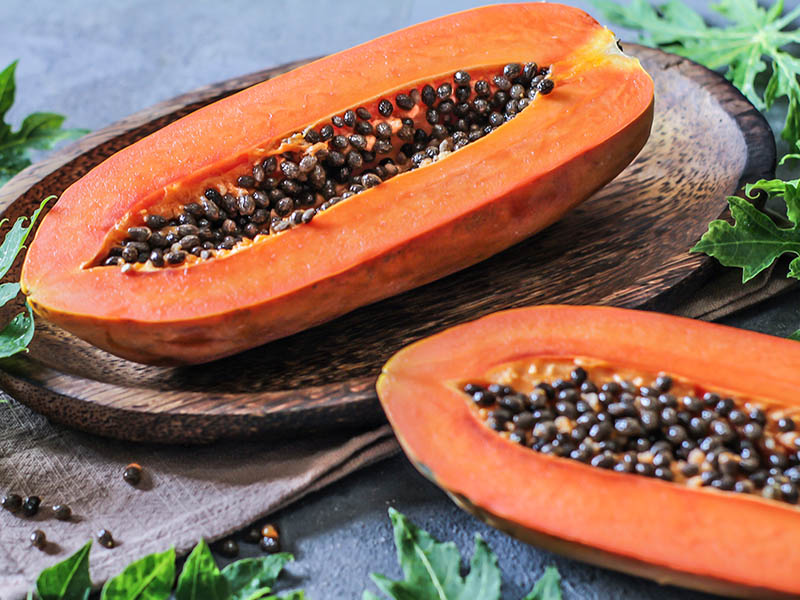
Papaya is a native fruit of tropical Southern Mexico and Central America. It is also one of the most common fruits in Vietnam. It is a big, long, or round fruit. Its color changes from green to yellow or orange when ripe.
Papaya has fragrant soft flesh and many black or brown seeds. Once overripe, it can create a strong fragrance. The Vietnamese consume Papaya when it is both unripe and ripe. Green Papaya is awesome when making salad or pickles.
People eat pickled green Papaya with many well-loved Vietnamese dishes such as baby duck eggs, shrimp salad, and grilled pork bread. They also love to eat ripe Papaya as a fruit. Papaya in Vietnamese means enough, so it is often present in the five-fruit tray at Tet to pray for sufficiency.
Nutrients: Antioxidants, carbohydrates, Vitamin C, vitamin A, vitamin B9, and potassium
Season: Nearly all year round.
How to eat: Cut in half, remove the seeds, and use spoons to enjoy the flesh. For green papaya, grate into long stripes and pickle.
14. Avocado (Bơ)
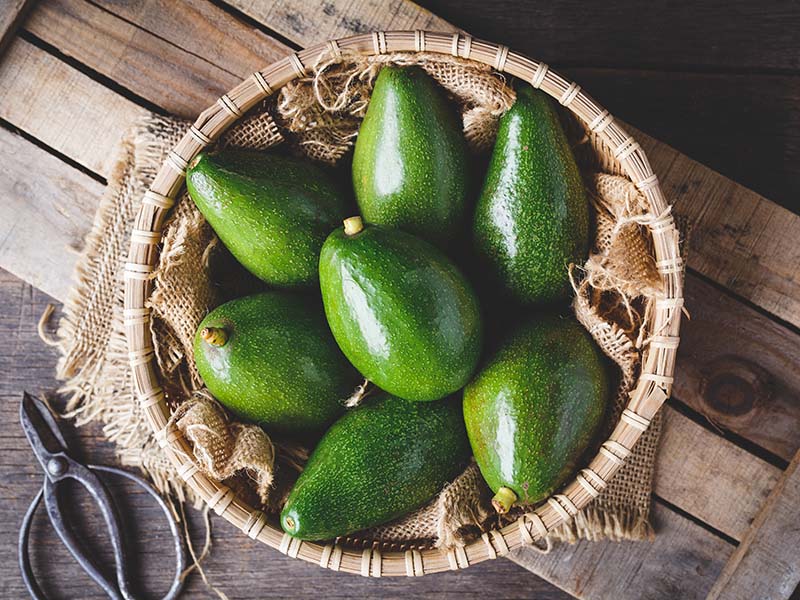
Avocados are a fruit derived from Guatemala and Mexico. It is one of the most versatile fruits presented almost all around the world. Avocados have thick dark green or purple skin with a big round seed.
The essence of Avocado is the soft pale green flesh. It is not only tasty but also nutrient-rich. Vietnamese people prefer Avocado smoothies and Avocado ice cream. When visiting Da Lat city, people recommend trying Avocado ice cream in the market.
Avocado is also a great ingredient in salad. Some of the outstanding health benefits are improving cardiovascular and digestive systems.
Nutrients: Calcium, magnesium, copper, potassium, vitamin E, folate, and dietary fiber.
Season: Mainly from May to September.
How to eat: Gently cut in half, remove the seed, and eat the flesh by spoon. Can also slice it to make salads.
15. Sapodilla (Sapoche/Hồng Xiêm)
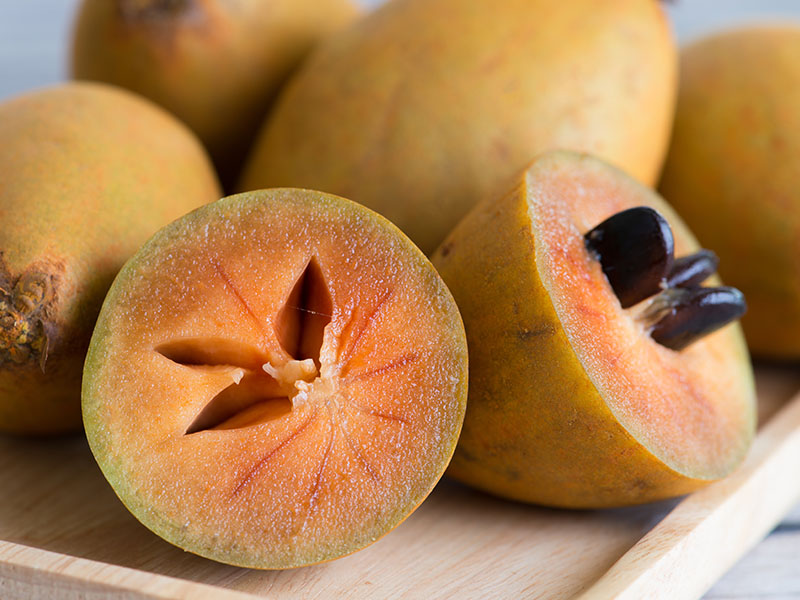
Sapodilla is a native fruit of Southern Mexico, Central America, and the Caribbean. Sapodilla was brought to Vietnam from Thailand. It is cultivated mostly in Southern Vietnam.
Sapodilla has thin, light yellow to brown skin. It usually contains several black seeds. The flesh of Sapodilla is very soft and sweet when ripe.
Vietnamese people usually consume fresh Sapodilla or combine it with other fruits to make smoothies. Good Sapodilla should not be too hard or soft when touched by hands.
Nutrients: Dietary fiber, tannin, polyphenolic, calcium, vitamin A, and antioxidants.
Season: Two main crops are from June to July and November to December.
How to eat: Peel the skin and eat the tender flesh. Remember to remove the seeds.
Let’s discover the Sapodilla garden in Vietnam.
16. Star Fruit/Carambola (Khế)
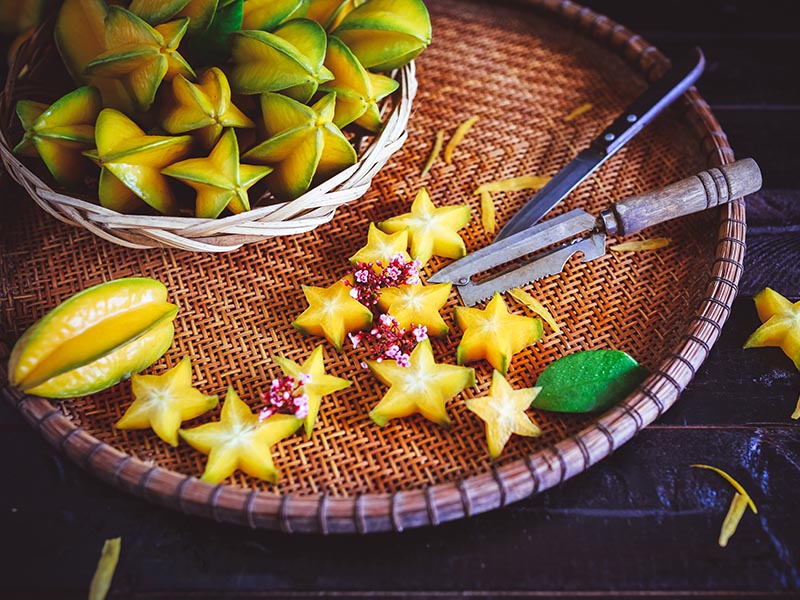
Star Fruit or carambola is a popular fruit in tropical countries and native to Southeast Asia. In Vietnam, there is a tale about Star Fruit trees and two brothers. A raven liked eating Star Fruit in the house of the younger and paid him back by carrying him to an island full of gold.
The greedy older brother switched their houses and brought a giant bag to collect gold. Because the bag was too heavy, the raven had to drop him with his gold into the sea.
Ripe Star Fruit is yellow with smooth skin and five-pointed curved parts. When cut into slices, it forms the shape of a star. Star Fruit is sweet or sour. It can be eaten raw or combined with other dishes such as Com Hen – a specialty in Hue province.
Nutrients: Dietary fiber, vitamin C, vitamin B, folate, and copper.
Season: Usually from August to October.
How to eat: Wash the fruit and slice to eat.
17. Lanzone/Langsat (Bòn Bon)

Lanzone or Langsat is native to Southeast Asia. In Vietnam, people grow it almost nationwide. It is a familiar fruit sold in markets and supermarkets. Lanzone is round with soft rind, translucent white pulp, and five to six segments.
Green Lanzone is sour but gets sweeter and changes to yellow when ripening. Many people love it because of its taste.
Though it is a great fruit, you should not eat its rind and seed since they contain a small amount of toxicity. Also, people who need to watch their sugar level should not consume it due to its high level of sugar.
Nutrients: Antioxidants, dietary fiber, vitamin C, vitamin B, and vitamin E.
Season: Peak season from July to September.
How to eat: Tear the rind and eat the flesh raw. Remember to remove the seeds.
18. Pomegranate (Lựu)
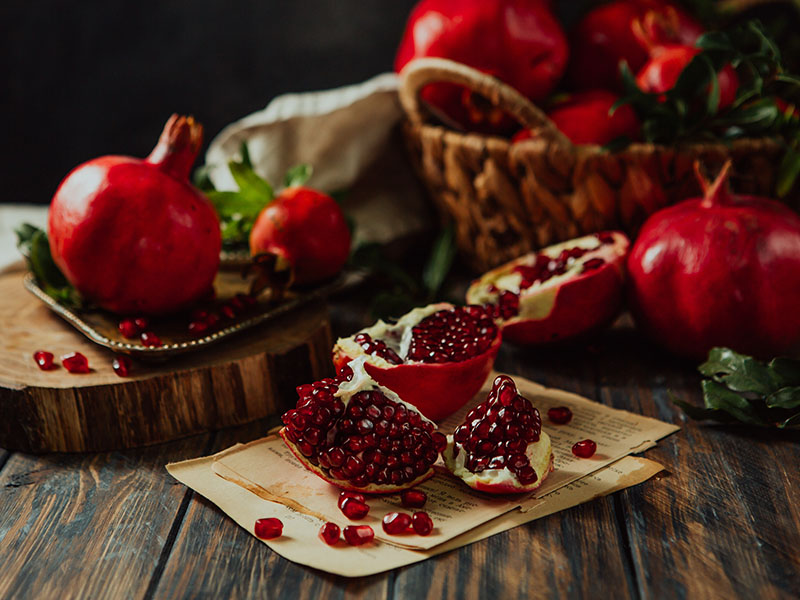
Pomegranate’s origin is in Southwest Asia. Nowadays, it is accessible in many countries in the world. Vietnamese Pomegranate is round with white or pinkish-white rind. It also contains a spongy inner mesocarp.
The flesh of Pomegranate is very different from other berry fruits. It contains hundreds to more than a thousand cells with corresponding edible seeds.
Pomegranates are sweet and sour. They are great when eating raw, but most people prefer making juice since they contain too many seeds.
Nutrients: Antioxidants (punicalagin), dietary fiber, protein, vitamin K, vitamin C, folate, and potassium.
Season: Fruits start to develop from September to the next February.
How to eat: Use a knife to cut a hexagonal shape around the stem, gently slit vertically starting at each point of the hexagon. Open the fruit, and enjoy the flesh.
4 Fantastic Multiple Fruits You Cannot Miss In Vietnam
Multiple fruits are those developed from more than one flower or a cluster. Let’s find out which Vietnamese fruits belong to this category.
19. Jackfruit (Mít)
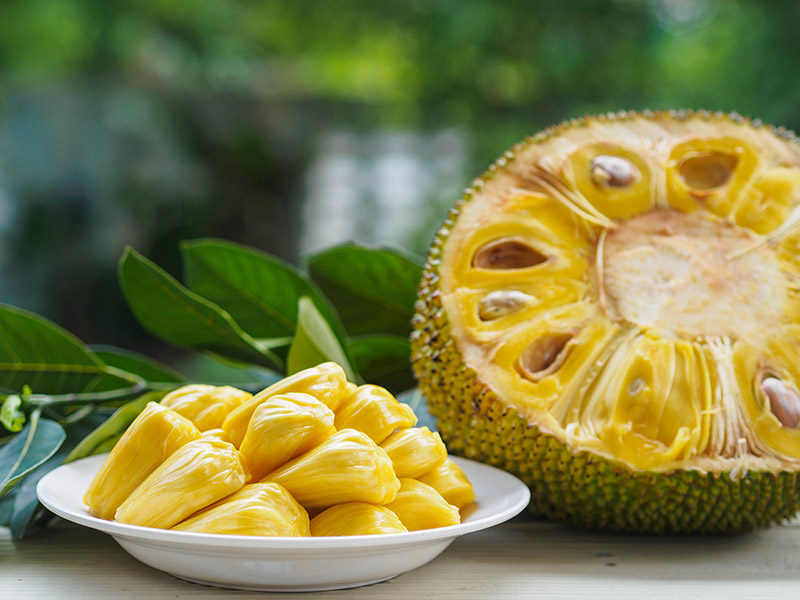
Jackfruit is a fruit originating in India and is mostly grown in Southeast Asia and Brazil. It is also the national fruit of Bangladesh. In Vietnam, jackfruits are a popular fruit and can be found nationwide.
Jackfruit is a big, if not giant, fruit with bumpy and rough skin. However, the flesh inside tastes like heaven. There are so many segments inside. Jackfruit is very fragrant, so when you put it in your house, everyone will know instantly.
Though the flesh is chewy, sweet, and delicious, it is quite hard to get them because of its resin. Therefore, to enjoy the treat, you have to be careful because the resin is hard to wash off your hands.
Nutrients: Vitamin A, vitamin C, calcium, potassium, and iron.
Season: Peak season is from July to August, though jackfruits can produce fruits all year round.
How to eat: You should wear gloves when handling jackfruits. Cut the fruit into small sections. Separate the segments and enjoy the flesh. The fiber is also edible but not as sweet as the flesh. The locals also steam the seeds to eat.
20. Mulberry (Dâu Tằm)
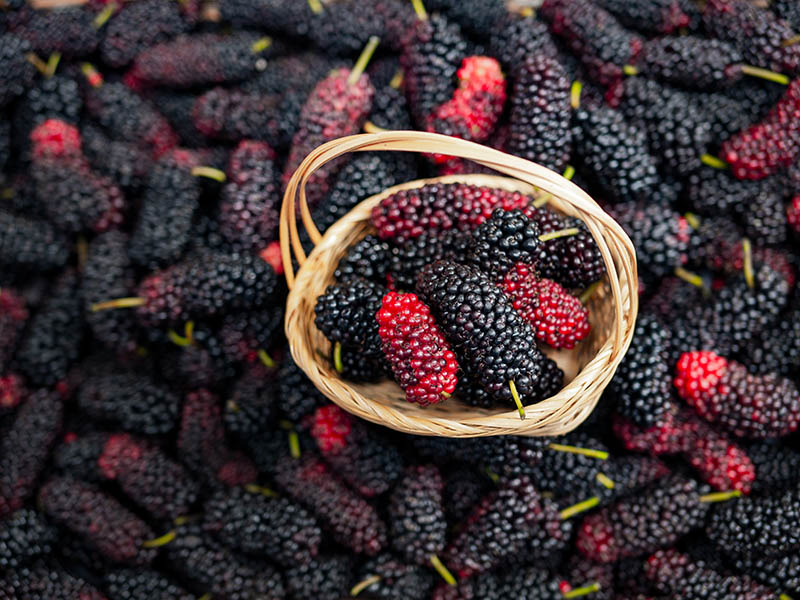
Mulberry is a type of tree whose leaves are the food of silkworms, so the name Dau tam in Vietnamese means berries and silkworms. People believe that mulberry’s origin is China. And now, it is popular in subtropical and temperate regions.
Vietnamese Mulberry changes from green to red to black when ripening. If you eat red mulberry, you may find it really sour. But black Mulberry is very sweet. In Vietnam, people usually eat fresh Mulberry and soak it in sugar to make wine.
Nutrients: Antioxidants, dietary fiber, vitamin C, vitamin E, vitamin A, calcium, and iron.
Season: Peak months from March to April.
How to eat: Wash thoroughly and eat fresh.
21. Strawberry (Dâu Tây)
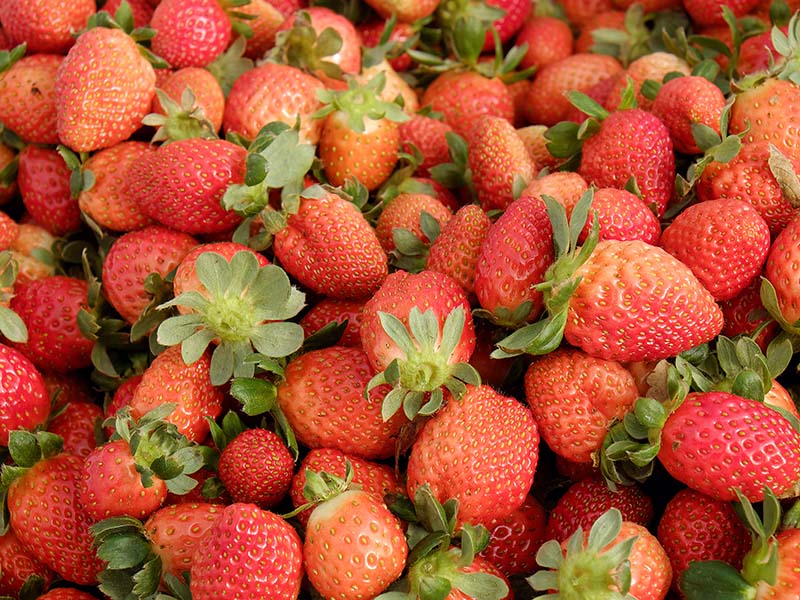
Strawberry is a temperate fruit, so in Vietnam, only places with a cool climate are suitable for strawberries. Da Lat is the most famous place for strawberries in Vietnam. People in Dalat grow strawberries in greenhouses, which have become a tourist attraction in Vietnam.
Strawberries in Dalat are fragrant, sweet, and sour. They are the best presents for friends and family when someone comes back from Dalat city.
The locals love to eat fresh strawberries or slice them to make cakes. Strawberry yogurt or smoothies are also popular desserts in Vietnam.
Nutrients: Dietary fiber, vitamin C, manganese, vitamin B9, potassium, vitamin B6, vitamin K, vitamin E, and iron.
Season: Begin in November until next April.
How to eat: Wash thoroughly and eat fresh.
Let’s follow these visitors to the Strawberry garden in Da Lat City.
22. Pineapple (Thơm/Dứa/Khóm)

Pineapple is native to Paraguay and Southern Brazil. In Vietnam, it is one of the most favored fruits. Pineapples have a bizarre look with tough, rough yellow skin with many spines. This fruit looks like they’re wearing crowns on their heads.
Pineapple flesh is sweet, sour, and tart. Together with Guava, Mango, and Ambarella, Pineapple is mouthwatering street food in Vietnam.
The local Vietnamese love eating Pineapple raw, making juice, and using it as an ingredient to cook fish soup. The sour and sweet Pineapple makes the soup taste better than ever.
Nutrients: Vitamin A, dietary fiber, vitamin C, manganese, calcium, phosphorous, and potassium.
Season: Almost all year round, but the peak season is from April to June.
How to eat: Use a knife to cut the skin and eat the flesh inside. Should not consume it when hungry.
How About Popular Citrus Fruits In Vietnam? What Are They?
Citrus fruits often have thick skin, pulpy flesh, and sweet-sour flavor. Let me help you discover the best citrus fruits in Vietnam.
23. Orange (Cam)
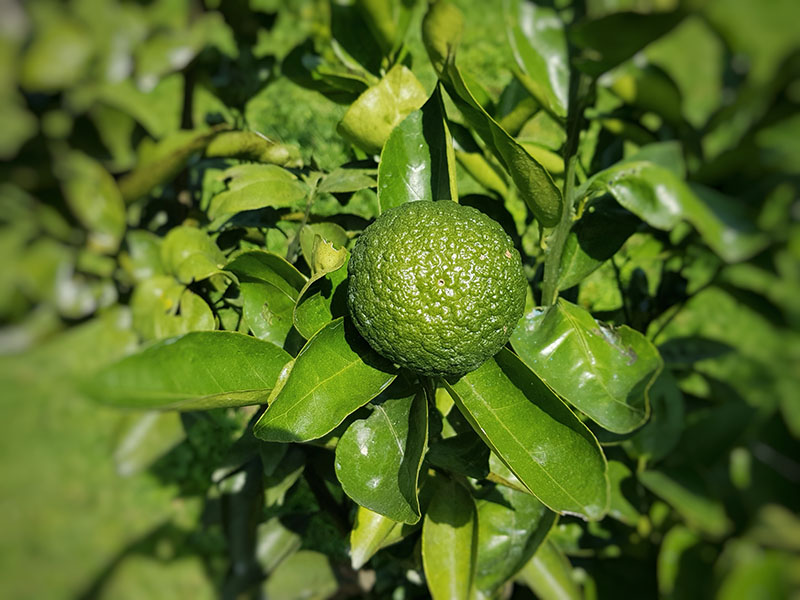
In Vietnam, the most famous type of Orange is Cam Sanh. This type is cultivated mainly in Southern and Northern Vietnam. It has a round shape, dark green, and rough skin. The flesh is vibrant orange or yellow.
Another famous variant is Cam Xoan, which is cultivated mainly in Southern provinces. Its typical feature is 2 small coin-shaped circles at its bottom and stem. Cam Xoan is very juicy, sweet, and has few seeds. You should pick ones that are small and greenish-yellow.
Orange juice is always one of the best beverages in the world. But you should bear in mind that you should not consume oranges when you are hungry because the high level of sugar and acid can trigger your stomach.
Nutrients: Vitamin C, dietary fiber, folate, antioxidants. High level of water and sugar.
Season: The main season is between October and November, and the side one is from May to June.
How to eat: Use a knife to cut the skin and eat the flesh inside. Should not consume it when hungry.
24. Mandarin (Quýt)
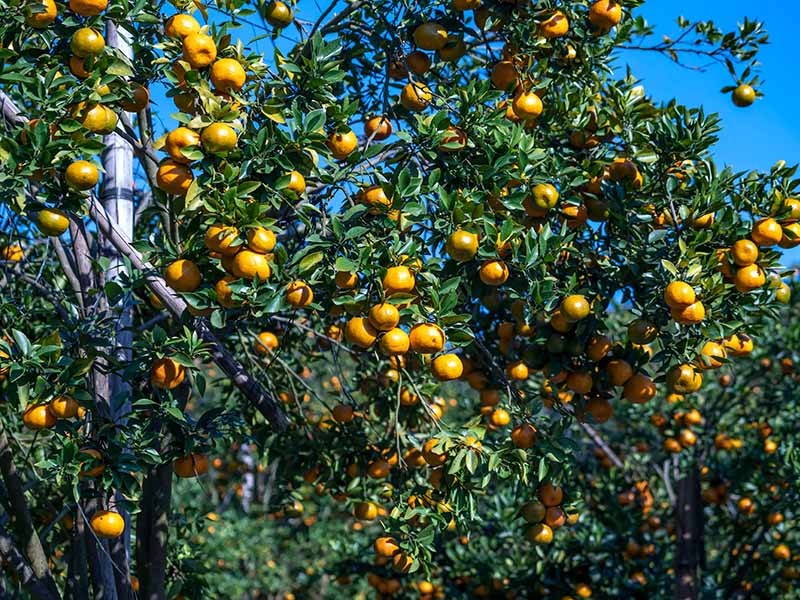
The next type of citrus fruit is mandarin. Compared to orange, Mandarin is smaller, and its rind is much easier to peel off. Mandarin is round with yellow or green rind depending on the type.
Mandarin also contains segments like orange, but it is easier to separate them from each other. One of the most famous types is Quyt Huong Can in Hue province. When peeling the rind, the fruit creates a pleasant fragrance. Its flesh is very sweet.
People believe that it used to be a specialty to offer to the King. Mandarin is a good source of vitamin C, so many housewives usually buy it for their families.
Nutrients: Potassium, calcium, vitamin C.
Season: Mandarin is available almost all year round.
How to eat: Peel off the rind, and consume the juicy flesh. Do not forget to remove seeds.
25. Kumquat (Quất)

Belonging to the citrus family, Kumquat has some similar features to Orange and Mandarin. However, Kumquat is much smaller and sourer compared to the other two.
Kumquat is used as a bonsai rather than a fruit tree. During the Tet holiday in Vietnam, many people choose Kumquat as a lucky tree. They buy kumquats and use them for home decoration.
If you have a chance to visit traditional flower markets in Vietnam at Tet, you will see thousands of Kumquat trees waiting to be sold. In cooking, the locals squeeze Kumquat juice into their dishes in place of limes.
Nutrients: Carbohydrate, dietary fiber, vitamin C, vitamin B, vitamin A, vitamin E, calcium, and manganese.
Season: Kumquat trees are popular during the Tet holiday. However, you can buy kumquat during their peak seasons, from November to June.
How to eat: Usually washed and squeezed into foods.
Let’s follow a visitor to see how Kumquat trees are sold during Tet.
26. Pomelo (Bưởi)
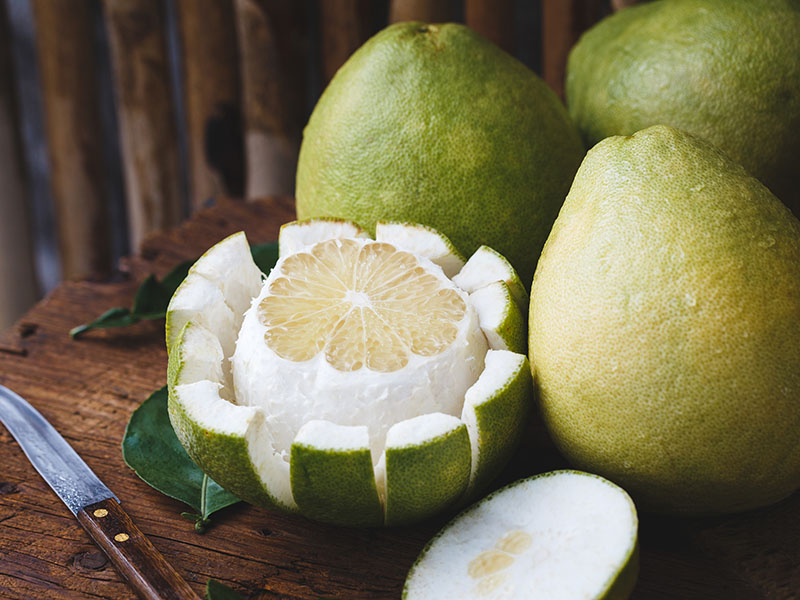
People think that the origin of Pomelo is the Malesian region. Compared to the other members of the citrus family, Pomelo is much bigger. It has a thicker rind, which can be used to cook a sweet dessert with mung beans, and Coconut juice.
There are various types of Pomelo in Vietnam, but the typical ones are Buoi Da Xanh and Buoi Nam Roi. Both of them are round, but the difference lies in their colors. While Buoi Da Xanh has a green rind, Buoi Nam Roi’s rind is greenish-yellow.
The flesh inside Buoi Da Xanh is pinkish-red and sweet. On the other hand, Buoi Nam Roi has a light yellow color and a sweet but slightly sour flavor.
Nutrients: Vitamin C, vitamin B6, calcium, magnesium, and dietary fiber.
Season: The peak season of Buoi Nam Roi is around September to October, whereas Buoi Da Xanh can produce fruits all year round, mostly from August to September. Yet most Vietnamese farmers know the techniques to make Pomelo produce fruits all year round.
How to eat: Use a knife to cut, then peel off the rind. Separate the segments inside and enjoy the pulpy flesh.
6 Other Exotic Fruits In Vietnam You Must Try
Vietnam also offers some more different types of tasty fruits you should not miss. They are diverse from appearance to flavor. And this Vietnamese fruit list cannot be complete without them.
27. Durian (Sầu Riêng)
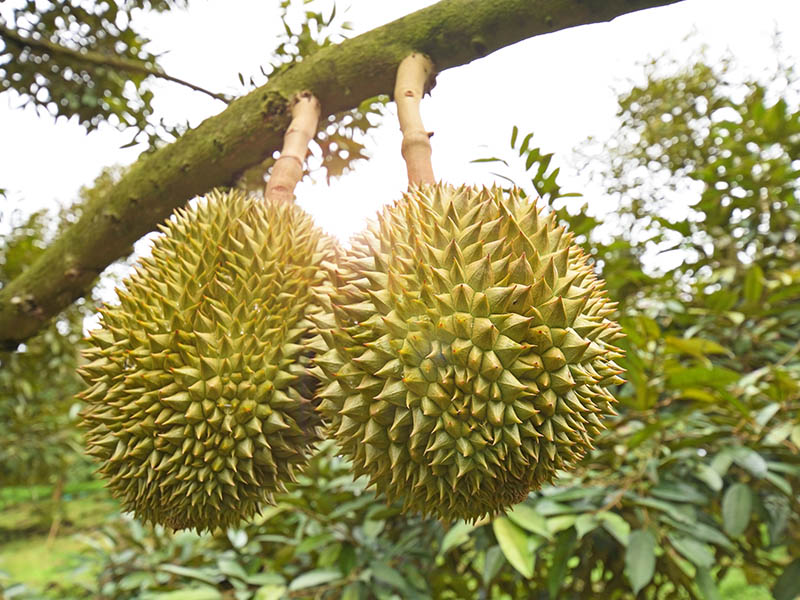
Durian is a tropical fruit native to Southeast Asia. In Vietnam, it is grown mostly in Southern provinces and also appears in the highlands in Lam Dong province.
If you notice the gap between Northern and Southern Vietnamese food, you also may know that durian can barely develop in Northern Vietnam. This is because it cannot withstand the cold weather in the North.
It has a similar appearance to Jackfruit, albeit with sharper and longer spines. Durian is well-known for its strong smell, which satisfies and terrifies two groups of people at the same time.
Due to its strong smell, Durian is prohibited in some restaurants and public transportations. Durian contains many segments with the flesh covering a big seed. Durian can be eaten raw or made into Che Thai – a famous sweet dessert.
Nutrients: Carbohydrates, vitamin B6, vitamin C, thiamine, potassium, manganese, folate, copper, and magnesium.
Season: Normally available in Vietnam from May to September. But the harvest season in lowland provinces is from May to June. The peak period in the highlands is from late August to early September.
How to eat: Cut the fruit in half. Get the segments and enjoy the flesh. Remember to remove its seeds.
Let’s see a visitor tries eating Durian in Vietnam.
28. Mangosteen (Măng Cụt)
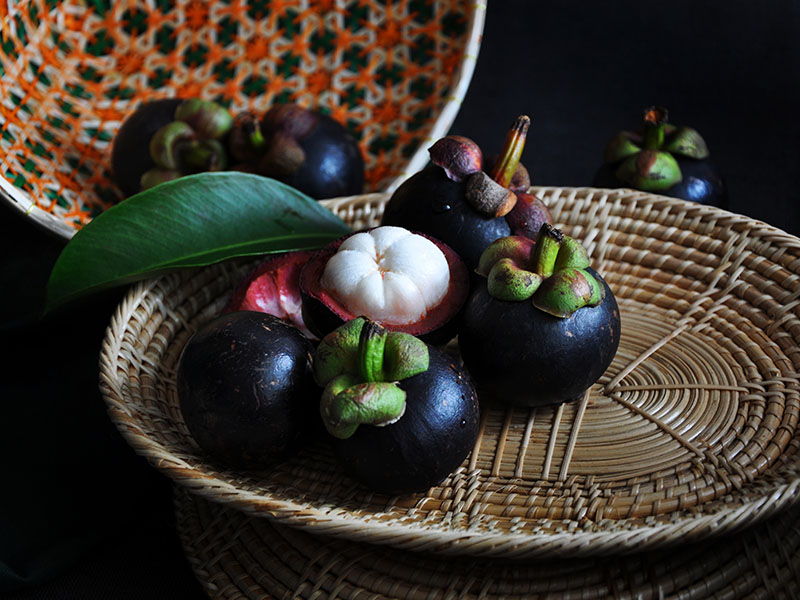
Mangosteen is a precious fruit in Southeast Asia. It has a special appearance with a round shape, and dark purple color. It has a stem with 3 to 4 leaves on one side and a small flower on the other. People say that the flower is used to show how many segments are inside.
The flesh of Mangosteen is divided into segments with or without seeds inside. Many people find the white pulp resembles the cats’ paws, which is a fun fact about this fruit.
Mangosteen tastes sweet and slightly sour. It is also a healthy fruit, so it would be a pity if you did not try Mangosteen.
Nutrients: Antioxidants, potassium, carbohydrates, dietary fiber, folate, and manganese.
Season: From April to June.
How to eat: Use a knife to cut the fruit in half. Open the rind, and enjoy the juicy white pulp inside.
29. Dragon Fruit (Thanh Long)
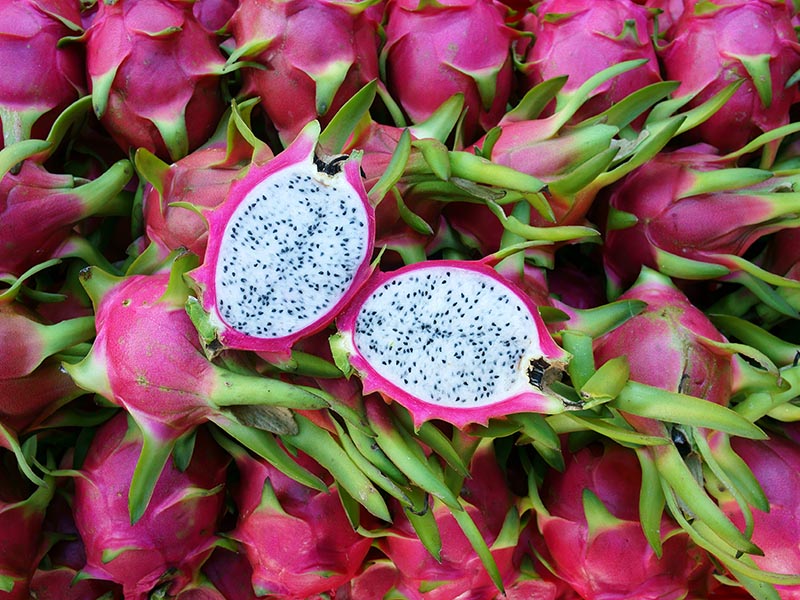
Dragon Fruits belong to the cactus category. They are derived from Mexico, Central, and Southern America. It is also a popular fruit in Vietnam and grows mostly in Binh Thuan, Long An, and Tien Giang.
They are a red, round fruit with many ‘spikes’ on the skin. Dragon Fruits have many edible black seeds inside the flesh, and removing them is nearly impossible. There are two types of Dragon Fruits in Vietnam: white flesh and red flesh.
Dragon Fruits taste mildly sweet and slightly sour. People say that they taste best when chilled. In Vietnam, you may find several specialties made from Dragon Fruits, such as bread. With the special pink color and flavor, they attract huge public attention.
Nutrients: Antioxidants, vitamin B2, vitamin B3, vitamin C, calcium, potassium, and phosphorus.
Season: Peak season from March to September.
How to eat: Use a knife to cut the fruit in half. Use a spoon or slice into pieces to eat. It can be made into smoothies.
30. Star Apple (Vú Sữa)
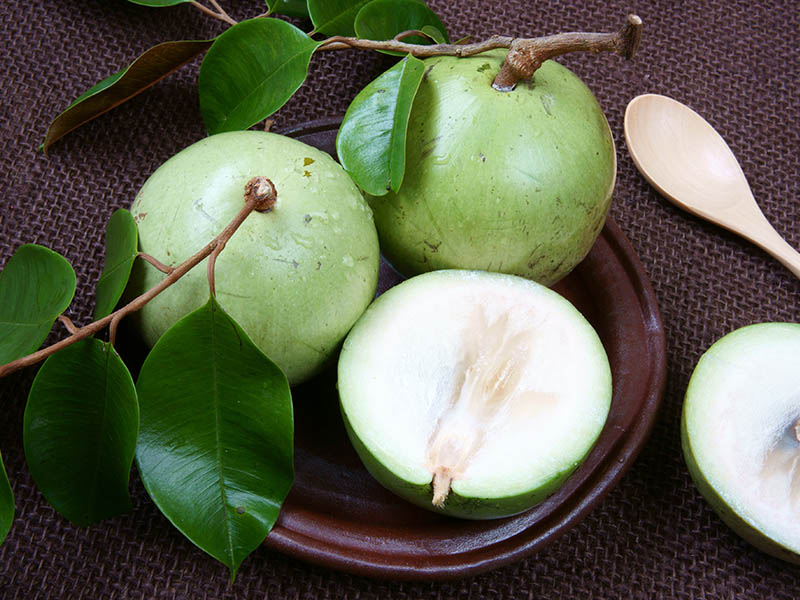
Star Apple originated from Antilles island and tropical America. In Vietnam, Star Apple orchards are mainly in Central and Southern Vietnam. You may find some most famous types in Can Tho – a province in the Mekong Delta.
A special thing about this tree is its leaves have two different colors on two sides. Star Apple fruits are round with smooth skin. There are two main types of Star Apple in Vietnam: green skin and purple skin.
Despite the color difference, they have similar tastes and fragrances. If you cut it in half, you will see the tender star-shaped white flesh. Besides the flesh, the juice is the essence of the fruits. The fruit’s flavor is so sweet that its Vietnamese name means breast milk.
Nutrients: Carbohydrates, vitamin C, vitamin B3, iron, and phosphorus.
Season: Peak season from January to March.
How to eat: Use a knife to cut the fruit in half, vertically or horizontally. Remove the seed, and use a spoon to eat.
31. Custard Apple (Mãng Cầu/Na)
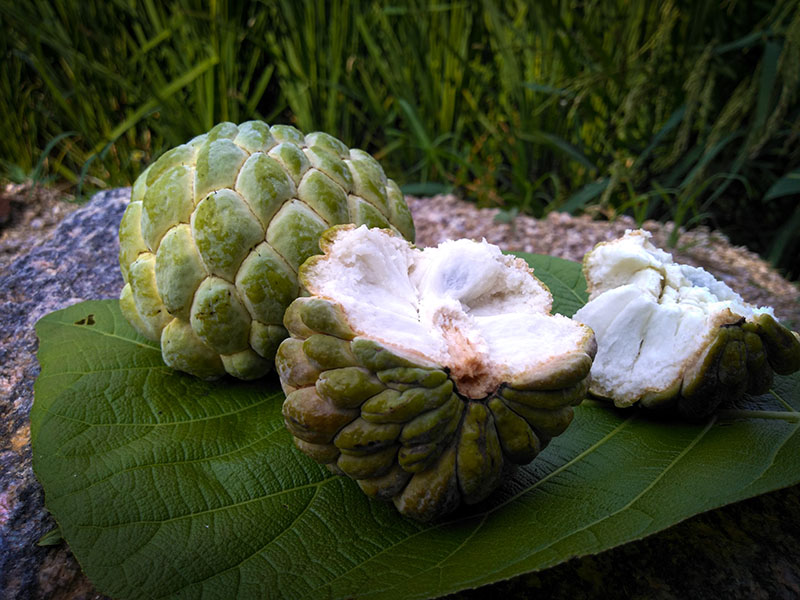
The next fruit on this list is the Custard Apple – a favorite of many Vietnamese people. It grows mostly in Southern provinces of Vietnam. Custard Apple belongs to the aggregate fruit family. There are two main types in Vietnam: firm and soft variants.
Its shape can be round, oval, or irregular. The skin contains many separate pieces which are easily peeled off when ripe. The flesh is white, very soft, and sweet. However, you should be careful when eating it since it also contains many black seeds.
Custard Apple is also present in the five-fruit tray during the Tet holiday because its name means hope. The full meaning of the five fruit is hoping to have enough for a fulfilling year.
Nutrients: Carbohydrates, vitamin C, vitamin A, vitamin B6, and magnesium.
Season: Peak season from June to September.
How to eat: Peel the outer skin and enjoy the flesh. Remember to remove seeds.
32. Rose Apple (Roi/Dao/Man)

The last fruit on this list is Rose Apple. It’s a tasty fruit that originated in Indonesia, India, the Philippines, and Malaysia. In Vietnam, It is a popular fruit with different names. While Northern people call it Roi, the Central people call it Dao, and Man is its name in the South.
Rose Apples have a bell shape and white, pink, or red color. The skin is very thin and edible, so you do not need to remove its skin when eating. Rose Apple flesh has white color, crunchy texture, and sweet, slightly sour flavor.
It tastes so good and juicy that you just want to keep eating. Vietnamese people love to enjoy it with a mixture of salt and chili. When choosing Rose Apple, you need to make sure the bottom segments are closed up because the holes may be the hint of worm eggs inside.
Nutrients: Carbohydrates, vitamin C, vitamin B, and dietary fiber.
Season: Peak season from May to July.
How to eat: Wash and eat it raw. Remove the seeds.
Vietnamese Fruits Will Not Let You Down
So, are you excited to try Vietnamese fruits? They are not only delicious but also good for your health. If you love Vietnamese foods, you should not miss these fresh fruits since they can give you an unforgettable experience and complete your trip in Vietnam.
If you find this post useful, I suggest you share it with your friends and family. If you know any other Vietnamese fruits, let me and other readers know in the comment section. Thank you, and see you again!



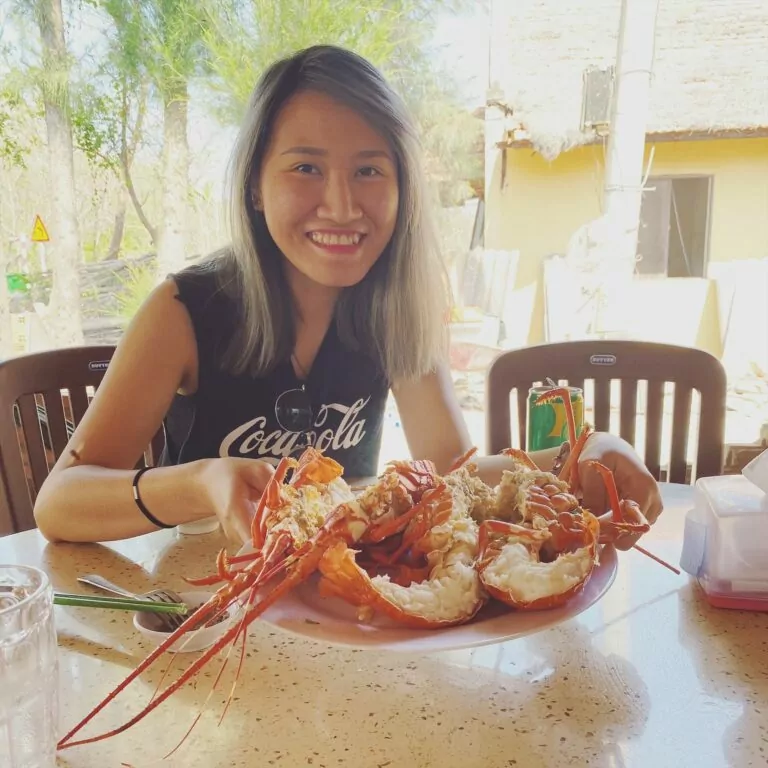
VERY GOOD INFORMATION. THANK YOU.